Amphibian Su-Ki - Japanese analogue of DUKW-353
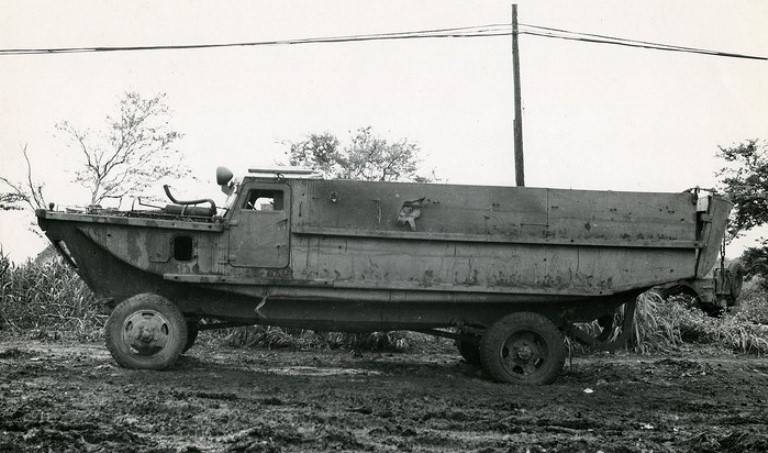
In 1942, during the Battle of Guadalcanal, the Japanese army, delivering supplies to the coast, faced the problem of a shortage of vehicles that would transport supplies from the ship to the beach and further inland to the operating units.
The shipments left on the beach were often shelled by Allied ships. The prospects of storing and transporting them to another place were sometimes very bleak: most of the equipment could simply be destroyed.
For this reason alone, the command of the army and fleet decides on the development of special cargo vehicles necessary for the transportation of goods directly from sea transport and cargo ships to inland warehouses. So the idea of an amphibious truck was developed, the concept of which was first announced after the Sino-Japanese War, when they first encountered the problems of amphibious transport.
The lack of amphibious vehicles in general in the Imperial Japanese Army (IJA) prompted, in mid-1943, to issue a technical assignment for the creation of three specialized vehicles for the needs of amphibious naval detachments and army units deployed in the Pacific Islands and in Southeast Asia, where the terrain is replete with water obstacles. Such means were to be an amphibious truck, a light duty amphibious vehicle and the equivalent of an American amphibious tracked carrier (LVT).
Work on a cargo amphibian began first.
The development was entrusted to Toyota. And this was logical, since this company has been researching and developing 4x4 all-wheel drive vehicles for many years. The engineers of the company took their 2-ton medium truck "To-Ki" with the 4x4 formula as the basis for the future car.
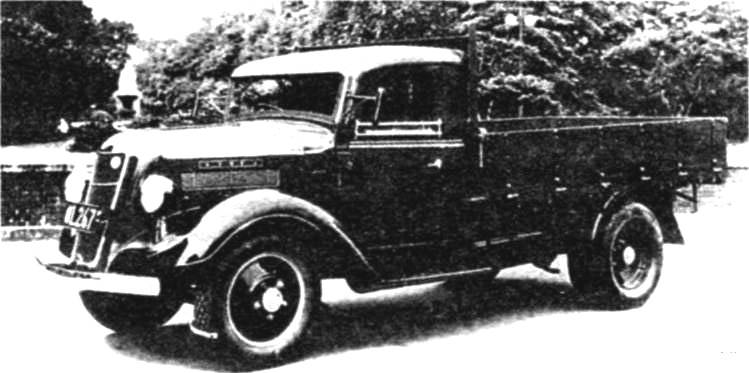
Truck "To-Ki"
The idea of using a serial truck, the Japanese, most likely, spied on the United States, where they already used the General Motors DUKW amphibian. But, unlike the American counterpart, the Japanese military asked for a closed cockpit and a cargo compartment with higher sides.
The body of the truck was made according to the boat. In the front part of the hull in the engine watertight compartment was the engine, and behind it was the cockpit with the crew. But, unlike its American counterpart, the cockpit was of a closed type with a sunroof and side doors for crew embarkation / disembarkation. The middle and rear parts were occupied by an open loading dock with one wide door.
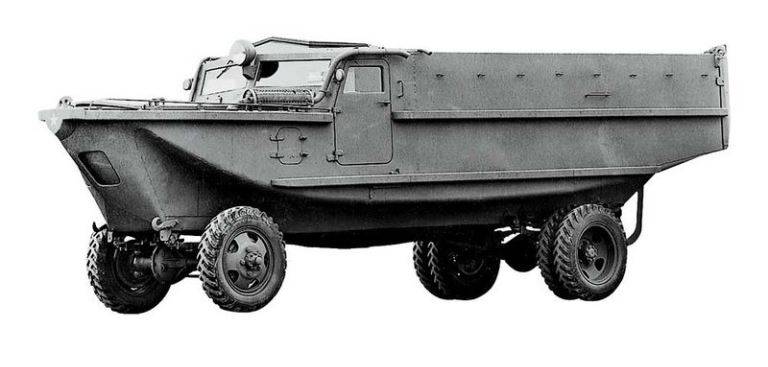
General view of an amphibious truck
To buy time, Toyota left the main drivetrain components in place. However, they, like the chassis, were moved outside the hull-boat. One of the key elements of the To-Ki truck was also retained: the car, with its innovative transfer case, could work in both 2-wheel and 4-wheel drive.
The new car was named "Su-Ki"
In total, without load, the car weighed 6,4 tons. The payload mass was 2 tons. The overall dimensions of the car were 7,6 m in length, 2,2 m in width and 2,4 m in height in general. ...
The amphibian was equipped with a 6 hp 65-cylinder gasoline engine. with. (according to other sources - 63 liters. from). The same was on the To-Ki truck. The engine accelerated the car and a top speed of 65 km / h. Unfortunately, there is no data on speed on the water.
To pump water out of the hull and engine compartment, a drainage system was developed and pumps were installed: on the left and right sides in the front of the machine.
For movement on water, a propeller was installed in the rear of the hull. But the rudder was completely absent. The driver made turns on the water using the front pair of wheels. At the same time, according to documents prepared after the war by US specialists, all four wheels were disconnected from the power drive when the propeller was turned on.
The amphibian did not have standard defensive weapons.
The armored steel hull was 5 mm thick, which provided armor protection against rifle fire and shrapnel.
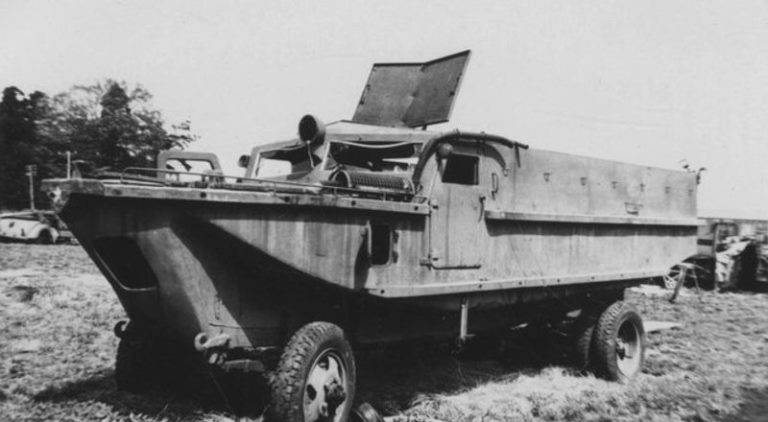
Amphibious vehicle "Su-Ki" with an open hatch in the cockpit roof. The hatch was used for an emergency exit for the driver, and possibly also to accommodate the observer.
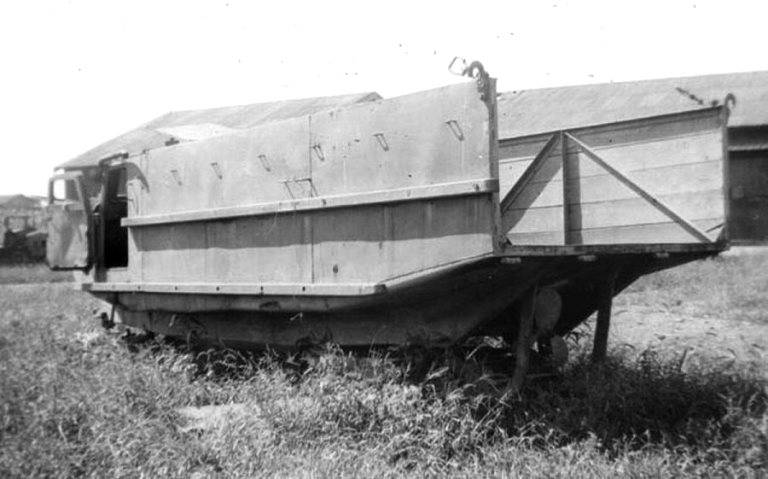
Amphibian "Su-Ki", rear view. A propeller is visible under the loading dock, there is no rudder
Behind the cargo compartment there was a swing door for easy access (exit) to the vehicle, loading / unloading any payload.
But was equipment and cargo loaded on board using a winch?
Unknown.
It is also unclear whether the kit included ramps for loading light equipment or personnel.
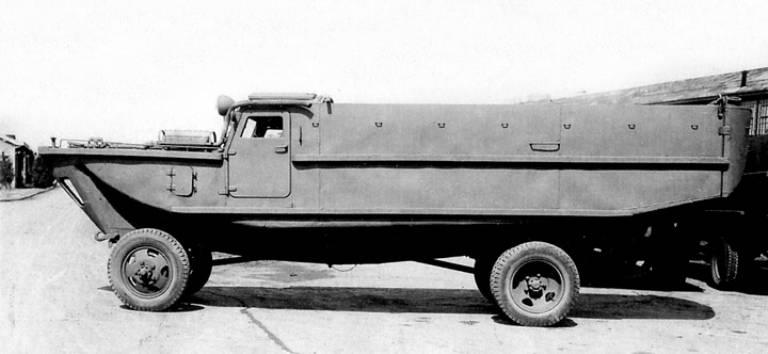
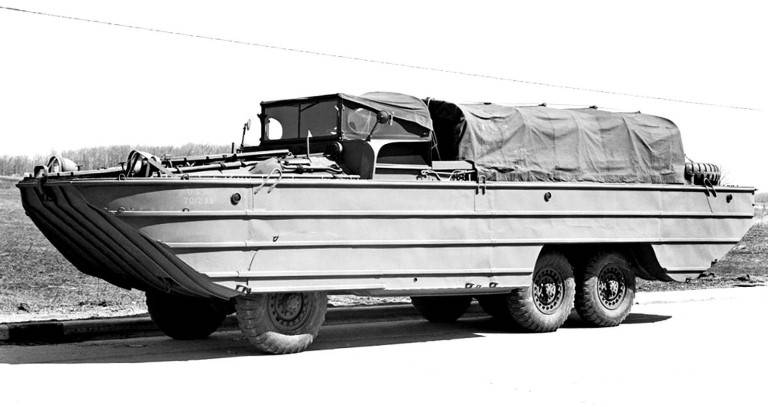
Amphibious "Su-Ki" (above) and the American amphibious DUKW: general view and layout comparison
The resulting car, compared to the allied DUKW, was a completely different beast: lightly armored, with a closed cabin, four-wheel drive, but it carried only 2 tons of cargo (versus 3,3 tons on the water for an American).
1943 amphibians were produced between November 1944 and August 198. The Su-Ki entered service in December 1943 or January 1944 and fought until the end of the war.
The Su-Ki landing amphibians were used by the Japanese armed forces in the Pacific Islands, but mainly in the Solomon Islands and the Gilbert Islands.
So, during the preparation of the landing on Ellis Island, almost half of the existing "Su-Ki" were collected. The Japanese military also developed their own tactics related to the new amphibians. In the beginning, as usual, the coast was handled by naval artillery and aviation.
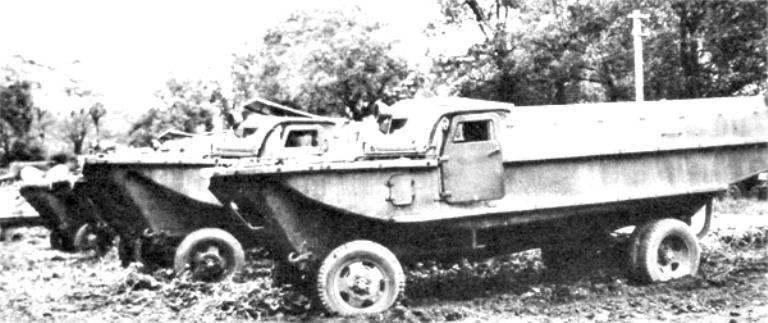
Several vehicles prepared for the landing on the island. Ellis, 1944
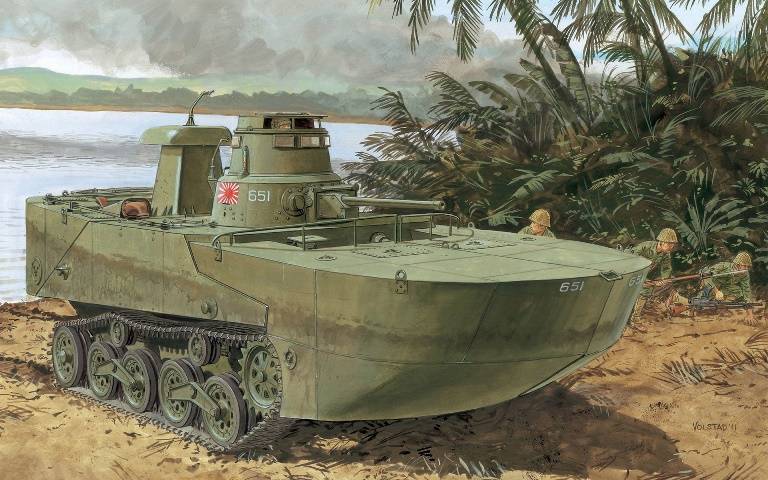
Floating tank "Ka-Mi", with which the amphibians "Su-Ki" were supposed to operate
After that, under the cover of aviation, floating Tanks Ka-Mi and Ka-Chi. Together with them, the amphibians "Su-Ki" with a landing party on board went out into the water to support the tank attack on the shore. In the second echelon there were other amphibians with reinforcements or equipment and ammunition, etc.
However, the operation, the purpose of which was to destroy the Allied airfields, ended in failure. At the same time, up to one and a half dozen amphibious vehicles were lost.
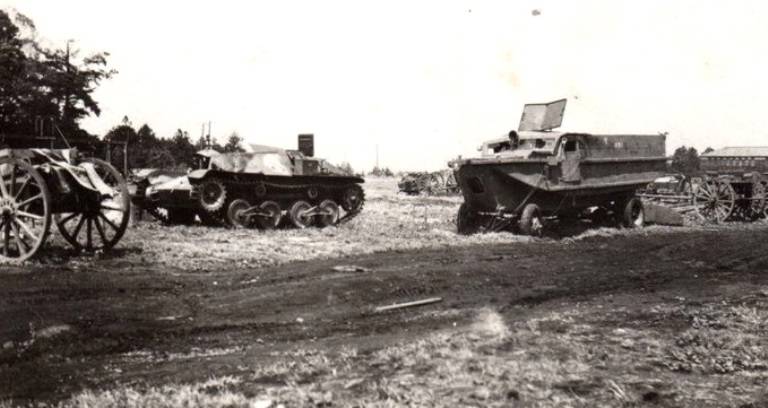
Cargo amphibious, abandoned during the retreat from about. Ellis
At the same time, the Ellis Island campaign raised the issue of building a special amphibious assault ship similar to the American armored amphibious vehicle LVT.
Work on the project began at the beginning of 1944 and continued intermittently until mid-1945. However, even a prototype was not made.
The reason lay in the fact that Toyota, after analyzing the use of Su-Ki machines, threw all its strength into its modernization.
So, the version of "Su-Ki 2" had to be tracked in order to improve cross-country ability, and even better armored in order to operate in battle formations with tanks. It was also planned to install 2-3 machine guns on the machine for self-defense and support of the landing on the shore. The development of this, already average, assault amphibian began at the end of 1944. The payload remained the same as on the previous vehicle, and the number of troops was reduced to 18–20 (versus 25 for its predecessor).
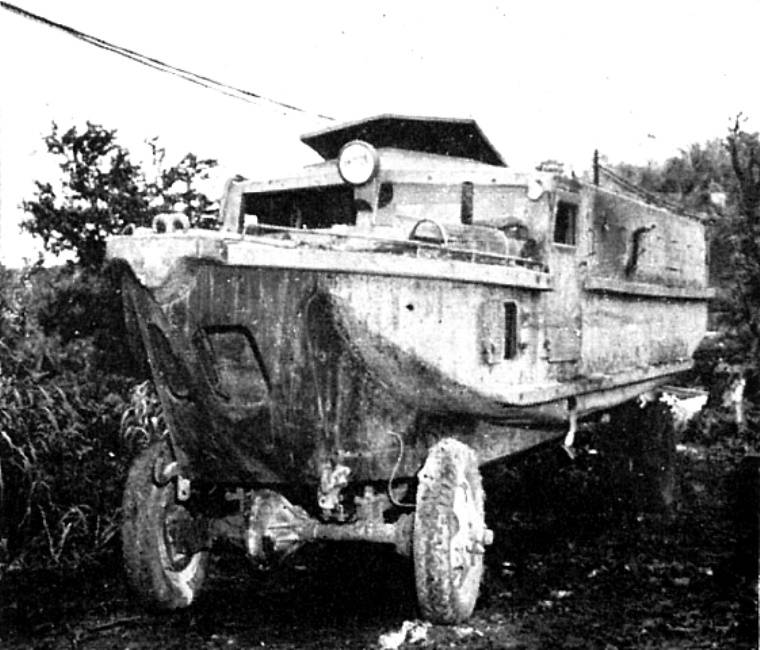
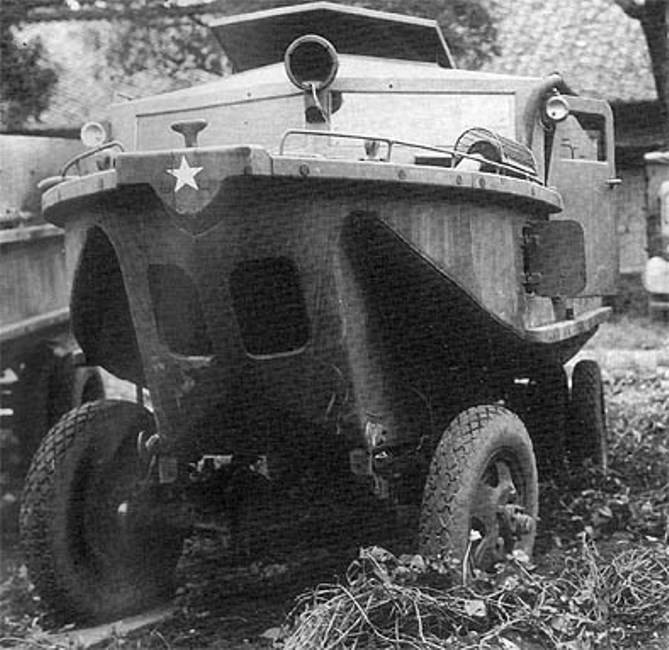
A pair of photos of the amphibious "Su-Ki". Front view. The front axle, hull contours and access hatches to the engine compartment are clearly visible
In the spring of 1945, Toyota began to improve the Su-Ki 2: it was planned to install heavy and light machine guns, grenade launchers on the car, and also to strengthen the protection in general. So there was, while on paper, the version of "Su-Ki 3". As a result of the installation of a whole family of weapons, the volume of the transported cargo decreased, the number of troops was also reduced.
However, the war ended in September 1945, and the Japanese did not have time to build a prototype of a new amphibian.
At the end of hostilities, most of the amphibians went to the American army. But the American military did not use them anywhere else, but simply dismantled them for scrap.
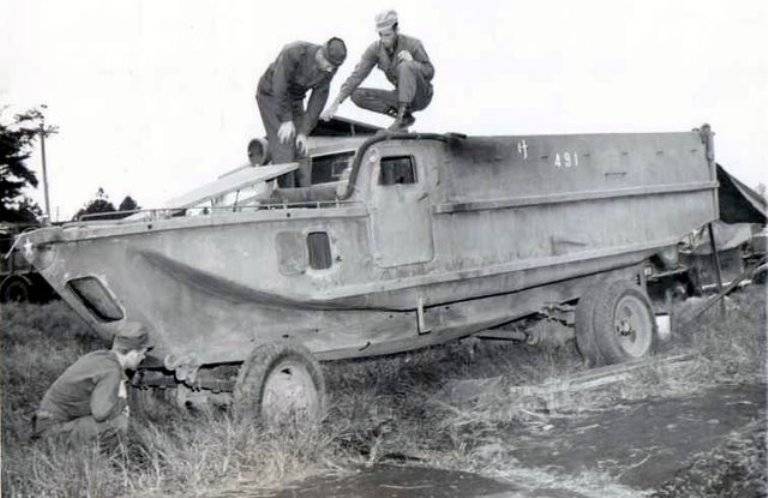
The US military examines the captured amphibious "Su-Ki"
Today, on the island of Ponape in Micronesia, you can find several abandoned amphibians "Su-Ki". Among them is the only more or less complete specimen, however, in a rather deplorable state.
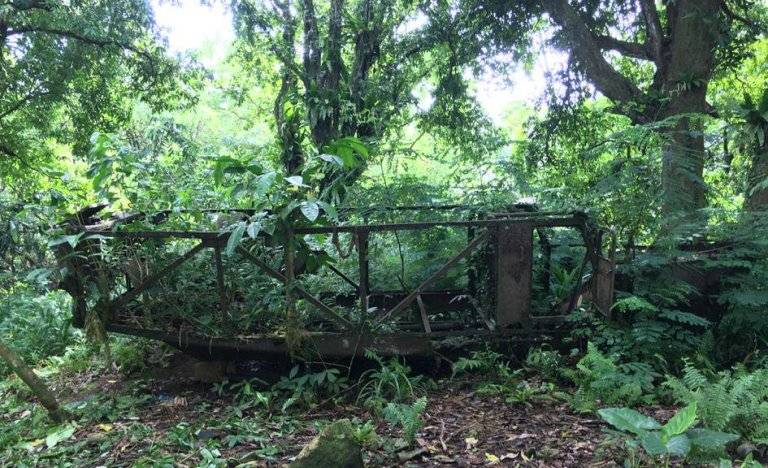

The amphibians "Su-Ki" that have survived to this day on the island. Ponape
The performance data of the amphibian "Su-Ki"
Make: Toyota
Series: November 1943 - August 1944
Produced: 198 pcs.
Crew + landing: 1 person. + 25 people
Weight: 6,4 tons
Loading capacity: 2 tons
Dimensions: 7,6x2,2x2,4 m
Maximum speed: 65 km / h (on land)
Engine: 6-cylinder petrol engine
Engine power: 65 l. with.
Information